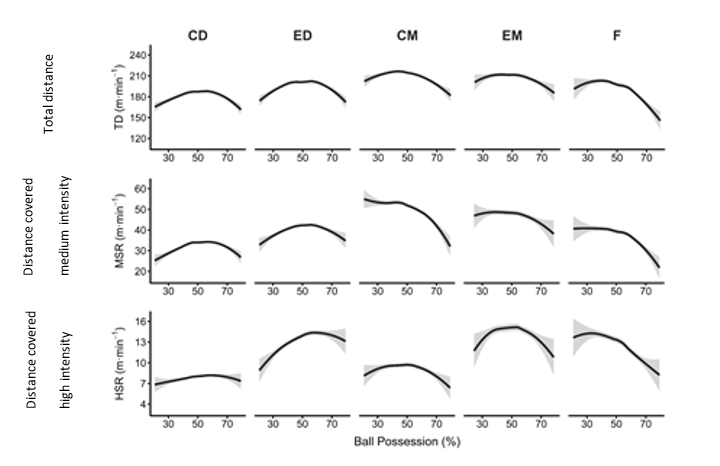February 1, 2021
Football
Team Sports
Do players run less when their team is in possession of the ball?
The arrival of Johan Cruyff as FC Barcelona’s coach in 1988 caused a revolution in the way the game is understood and footballers are trained. One of his best-remembered comments was that: “All coaches talk about movement, about running a lot. I don’t think players need to run that much. Football is a game that’s played with the brain. You have to be in the right place at the right time, not too early and not too late”.1 His focus on possession of the ball and the use of space and superiority in numbers reduced the importance of physical performance in the game. In another quote, he noted: “My forwards should only run 15 metres”.
Scientific research seems to prove him right. A recent publication2 analysed how ball possession influences physical performance in high-level players. The study, published in Science and Medicine in Football in 2020, was based on an analysis of the 380 games played in the Spanish LaLiga in the 2018-2019 season. In total, it examined the competitive behaviour of 412 players who played the full ninety minutes to obtain 8,468 observations. The footballers were classified into 5 different positions: Central Defenders (CD, number of observations = 2,452), Full Backs (FB, number of observations = 1,822), Defensive Midfielders (DM, number of observations = 2,022), Attacking Midfielders (AM, number of observations = 1,020) and Forwards (FW, number of observations = 1,152). Physical performance was analysed considering the following categories: total distance covered, low intensity running (0–14.0 km/h), medium intensity running (14.1–21.0 km/h), high intensity running (21.0 km/h), very high intensity running (21.1–24.0 km/h) and sprint (>24.0 km/h). All these variables were calculated taking into account the actual playing time and were normalised to metres per minute. Actual playing time refers to the duration of the match after deducting the time used for stoppages, substitutions, goals and injuries, in other words, time when the ball is not in play. A cluster analysis divided the teams into four categories based on the percentage of possession they had in each game: teams with very low possession (35.2 ± 4.2% ball possession, with a range of 20.7 –40.3%, n=1648), teams with low possession (45.5 ± 2.8% ball possession, with a range of 40.4–50.0%, n=2594), teams with high possession (54.5 ± 2.8% ball possession, with a range of 50.1–59.7%, n=2589) and teams with very high possession (64.9 ± 4.2% ball possession, with a range of 59.8–79.3%, n=1637). Physical performance was recorded using the TRACAB tracking system used by Mediacoach.
The results suggest some remarkable conclusions:
- When the specific position is not taken into account, players in teams with very high possession of the ball cover significantly less distance than the players in teams with high, medium and low possession of the ball. Having a lot of the ball reduces the distance covered by footballers.
- However, these differences depend on a player’s specific position. Attacking players (DM, AM and FB) of teams with very high ball possession covered fewer metres per minute at any speed range than in other teams. For example, defenders in teams with very high ball possession travelled 5.2 metres/minute compared to 7.8, 7.3 and 6.7 in teams with very low, low and high ball possession, respectively. When the metres/minute covered by AM are compared, the values were 7.0, 7.2, 7.1 and 7.8 metres/minute, respectively. Finally, distances of 3.7, 3.9, 4.0 and 4.2 metres/minute were found for DM.
- On the other hand, defenders (CB and FB) in teams with very low possession of the ball were the ones who travelled the least distance. For example, the FBs in these teams covered 6.1 metres/minute by sprinting compared to 7.1, 7.7 and 7.5 for the teams with low, high and very high ball possession. Similarly, the CBs travelled 3.4 metres/minute compared to 3.9, 4.0 and 3.9 for those in teams with low, high and very high ball possession, respectively.
These results are described in the Figure below.

Although these results should be viewed with caution due to the complex nature of football, they can help coaches to better understand the physical demands of the game and to develop models that can predict the physical performance of players depending on the kind of football played by each team. Having the ball is the most important thing in football.
Carlos Lago Peñas
References:
1https://www.lavanguardia.com/deportes/20160324/40657275538/johan-cruyff-mejores-frases.html
2 Lorenzo-Martínez, M.; Kalén, A.; Rey, E.; López-Del Campo, R.; Resta, R. & Lago-Peñas, C. (2020). Do elite soccer players cover less distance when their team spent more time in possession of the ball? Science and Medicine in Football, ahead of print. (https://www.tandfonline.com/doi/abs/10.1080/24733938.2020.1853211?journalCode=rsmf20).
KNOW MORE
CATEGORY: MARKETING, COMMUNICATION AND MANAGEMENT
This model looks to the future with the requirements and demands of a new era of stadiums, directed toward improving and fulfilling the experiences of fans and spectators, remembering “feeling” and “passion” when designing their business model.
CATEGORY: FOOTBALL SPORTS PERFORMANCE
Through the use of computer vision we can identify some shortcomings in the body orientation of players in different game situations.
CATEGORY: MEDICINE HEALTH AND WELLNESS
A health check must detect situations which, despite not showing obvious symptoms, may endanger athletes subject to the highest demands.
CATEGORY: FOOTBALL TEAM SPORTS
In the words of Johan Cruyff, “Players, in reality, have the ball for 3 minutes, on average. So, the most important thing is: what do you do during those 87 minutes when you do not have the ball? That is what determines whether you’re a good player or not.”
CATEGORY: MEDICINE HEALTH AND WELLNESS SPORTS PERFORMANCE
Muscle injuries account for more than 30% of all injuries in sports like soccer. Their significance is therefore enormous in terms of training sessions and lost game time.
DO YOU WANT TO KNOW MORE?
- SUBSCRIBE
- CONTACT
- APPLY
KEEP UP TO DATE WITH OUR NEWS
Do you have any questions about Barça Universitas?
- Startup
- Research Center
- Corporate